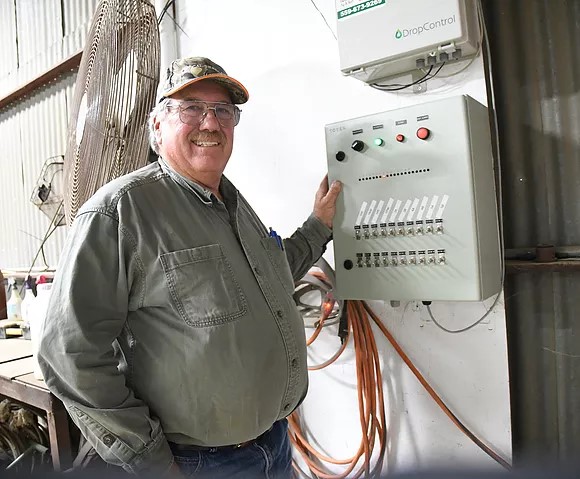Rogers uses new tech to grow crops
July 31, 2017 Cassandra Garibay Madera Tribune

Wendy Alexander/The Madera Tribune
Tom Rogers shows off his irrigation box, which has allowed him to cut his water usage.
Overlooking 175 acres of almond orchards that are utilizing advanced technology to irrigate and farm, sits a barn that was built in the 1870s. Tom Rogers and his brother Dan own the property that is a mix of the past and future of farming in California.
The brothers inherited the property that was believed to be purchased by their grandfather in 1916. Yet, Tom Rogers credited his father for introducing his brother and himself to the benefits of technology being used to farm.
“I give credit to our dad because he has had soil moisture probes since about, I think, the mid 80’s. So, I mean we have always looked at different ways of irrigating,” said Rogers.
However, a scare that took place four years ago pushed Rogers further into the future of farming. After losing one of the ranch’s two wells, the brothers turned to alternative watering methods.
“We were fortunate it was a mechanical failure and not that the hole went dry. But we were still without water for a full month and we had to experiment with moving water around,” Rogers said. “From that point it really opened our eyes to what possibilities are out there.”
Prior to the well breaking, Rogers would water the ranch every day in 36 to 48 hour sets.
However, after speaking with California Ag Solutions and reaching out to other resources, Rogers discovered that it was more effective to water less but within a quicker interval of time.
Now, his older orchard is watered three times a day through an underground drip system, using far less water than before. The underground drip system, which Rogers is trying out for the first time this year, is buried a few inches deep to, hopefully, strengthen the roots.
“There are studies that indicate, especially for almonds, it is the top 18-inches where a majority of all root activity happens. Well, then what am I worried about watering to 36-inches when where I really want it is in the top 18?” Rogers said. “You do need to have deep moisture just you don’t need to water down there every time.”
In addition to helping the root activity strengthen, Rogers said, the underground system helped in controlling mice biting into drip lines.
His newest orchard, however, is watered nine times a day for 20-minute intervals, all of which is controlled by a computer. The method is known as pulse irrigation.
“The first year that we used pulse irrigation, we probably saved 25 percent of our water and had one of our better crops. And it’s just been a matter now of fine tuning what we do, and that will continue forever,” said Rogers.
Since his ranch is only 175 acres, Rogers has been able to experiment with different farming techniques.
“Being small like this gives us the opportunity to play around with technology and do things that maybe you wouldn’t try if your were on a larger scale,” Rogers said.
Weather stations scattered about his orchard send temperature, solar radiation, and wind speed to a computer to calculate the evapotranspiration. Evapotranspiration, according to Rogers, is the measurement of how much water a tree uses.
By calculating how much water the tree needs, Rogers is able to be exact in his water usage. Since the State Groundwater Management Act will eventually limit water usage, Roger’s wanted to stay ahead and is able to with weather stations.
“One of the things the State Groundwater Management Act is going to do, is tell us how much groundwater we can pump. Well, it’s not going to be as much as we are pumping now so we are going to have to become extremely efficient with what we are doing,” said Rogers.
Along with weather stations and pulse irrigation, Rogers has developed a way to water one side of the tree at a time. He has begun to experiment with this technique in his two-year-old orchard.
Studies have shown that oxygen in the soil is equally as necessary as water, said Rogers. By watering one side one day and the other side the next day, he is hoping to improve oxygen levels in his soil profile.
“Really, when you think about it, the soil health should be our main focus because that’s what the tree is growing in. So the question is ‘How do we maintain that and bring it to its optimum?’” Rogers said.
So far, Rogers has seen great crop production, resulting in nearly 3,000 pounds per acre. However, Rogers said that each piece of land is different and he is always looking for new technology to further improve his crop.
“The reality is, we have to do something to become more efficient because it is going to be driven by regulation,” he said. “So if I can grow 100 acres of trees instead of only 80 with the water I’m giving, then I’m way ahead of the game.”

